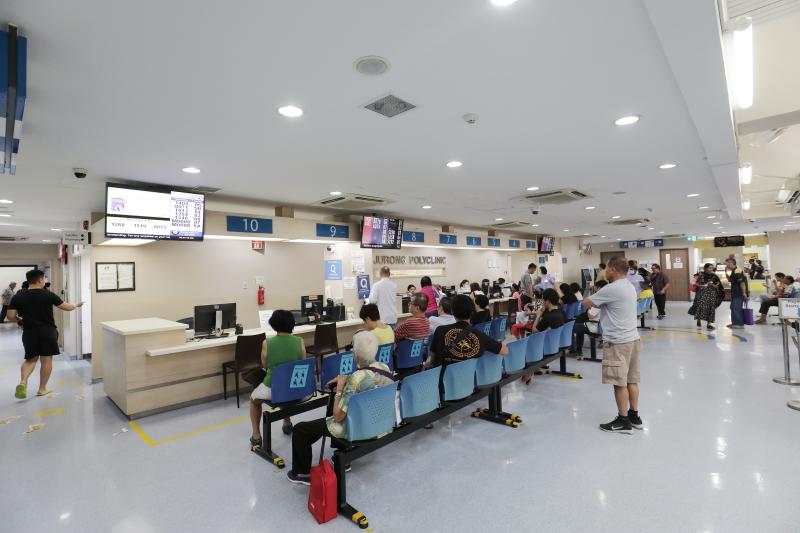New health hub in Jurong to integrate bigger polyclinic with 700-bed nursing home
Sign up now: Get ST's newsletters delivered to your inbox

A waiting area at Jurong Polyclinic, on April 30, 2019. The new health hub in Jurong will include a new polyclinic and a 700-bed nursing home.
PHOTO: LIANHE ZAOBAO
Follow topic:
SINGAPORE - A new health hub will be built in Jurong that integrates a much bigger polyclinic with a 700-bed nursing home that will also provide short-term care for the elderly so caregivers can have a break.
Announcing this on Tuesday (April 30), Senior Minister of State for Health Lam Pin Min said the move is timely as Jurong's population is older than the national average.
By 2025, when the new polyclinic and nursing home are ready, one in four residents would be more than 65 years old.
To cater to them, the polyclinic will have wider corridors to allow easy wheelchair access.
It will be located 150m from the current polyclinic and 2½ times larger.
The clinics will be built for teamlet care, where patients with complex chronic conditions are looked after by a team of doctors, nurses and care managers.
The nursing home will be located next to the new Jurong Polyclinic to allow for synergy and some shared services.
Mr Ang Wei Neng, an MP for Jurong GRC, said Jurong Polyclinic used to be the most crowded in Singapore until Pioneer Polyclinic in Jurong West was opened in 2017 and took some of the load, although it remains crowded.
He added that the new polyclinic will have a more conducive environment.
This is the second nursing home and polyclinic to be co-located. The first is at Bukit Panjang.
Dr Lam, who visited Jurong Polyclinic on Tuesday, said: "With the ageing population and increased prevalence of chronic diseases, there is an urgency to strengthen primary care and anchor the management of these conditions within the community."
This is why the Ministry of Health (MOH) is building more polyclinics as well as expanding the Community Health Assist Scheme (Chas) to cover more people.
Older polyclinics are being renovated, while several new ones are being built.
By 2030, there should be 30 to 32 polyclinics, up from the current 20.
From November, Chas will cover another half a million people - those born from 1950 to 1959, or the Merdeka Generation.
There will also be a new green card for households with a monthly per capita income of more than $1,800 or a home with an annual value of more than $21,000.
The Chas Green tier is in addition to the existing Chas orange and blue cards and gives up to $160 in subsidies a year.
MOH had earlier announced an additional 25 per cent subsidy for services and medication at polyclinics for the Merdeka Generation from November.
Pioneers already enjoy an additional 50 per cent off.
Dr Lam also announced some changes to strengthen Chas including a cap on the number of visits to a general practice (GP) clinic for acute problems.
Patients now receive subsidies for up to four visits a month to one GP clinic.
But under the current scheme, a patient could visit different clinics and receive subsidies up to four times a month at each clinic.
This will change from January next year to a maximum of 24 visits for acute problems a year.
About 99.5 per cent of patients now see GPs for acute problems under Chas, fewer than 24 times a year.
Dr Lam said those who need more visits can file an appeal and subsidies may be extended on a case-by-case basis.
However, Dr Lam added that someone who needs to see a doctor that often may be better off seeing a specialist.
Dental claims have also been tweaked to align with changes in prices and practice.
One example is tooth filling. Currently, the subsidy for tooth-coloured filling is higher than for amalgam.
This will be consolidated from Nov 1 as the price of the tooth-coloured filling has come down and is now only slightly more expensive than amalgam.

